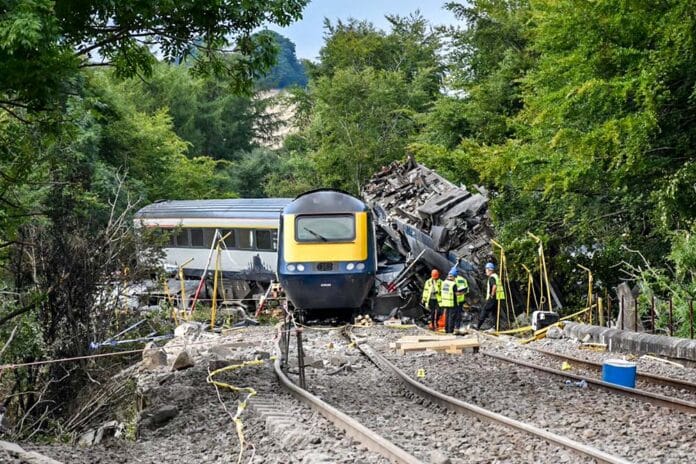Rail Union RMT has said it is concerned at Network Rail’s progress on key safety recommendations on the second anniversary of the Stonehaven incident.
Network Rail, meanwhile, refutes this, saying that any future changes to working have been properly assessed and if anything will make rail safer.
The incident at Stonehaven, Aberdeenshire, (also referred to as the Carmont derailment) was a tragedy that took the lives of three people and injured six, two years ago.
The three killed were all rail employees. Donald Dinnie was a conductor, Brett McCullough was a driver, and another driver, Christopher Stuchbury, was travelling as a passenger at the time.
During a period of harsh weather, a train struck debris that had been washed across the track. The train lurched left and hit a bridge parapet, scattering train carriages.
The Rail Accident Investigation Branch (RAIB) recently catalogued a series of issues, none of which had anything to do with the driver or the team on the train at the time. At the forefront was faulty drainage works, delivered by what at the time was one of the biggest construction companies in the country, Carillion. This resulted in debris washing onto the track during heavy rainfall.
But there were also issues with procedure and training, RAIB said.
In all, RAIB made 20 recommendations for the improvement of railway safety. These cover: How the railway manages extreme weather events, management of civil engineering construction activities, management assurance of railway control functions, train design, and applying learning from previous events.
Today, RMT general secretary Mick Lynch said: “We are extremely concerned that Network Rail is dragging its feet dangerously on key safety recommendations following the Carmont Rail Tragedy.
“In fact, instead of focusing on improving rail safety, it is proposing to make matters even worse by cutting thousands of safety critical jobs across the network.
“Our railways do not need safety cuts which will make it more likely tragedies like Carmont will happen again.
“Network Rail needs to act on safety recommendations and swiftly reverse its safety critical jobs cull.”
In response, a Network Rail spokesperson said: “Britain’s railway is the safest major network in Europe and we would never consider any changes that would make the railway or our people less safe. We have a strong record of safety leadership and we would not bring forward ideas or proposals that would compromise safety.
“There have been many changes to the railway over the last 20 years and over that time railway safety has only improved, often despite initial resistance to changes from trades unions. In fact, the ideas we have for modernising maintenance looks to improve the safety of the workforce by reducing unnecessary track-side inspections and cyclical scheduled tasks and using technology and remote condition monitoring (as we see in the oil and water industry) instead. Any changes we propose would first need to be scrutinised and approved by the ORR – our independent safety regulator.”
ORR said there had been good progress towards improvements following the incident. In an annual assessment in July it said: “We found that Network Rail had a prioritised programme of action plans to address the recommendations. It must now ensure sustained, co-ordinated oversight of the many complex and interdependent work streams to deliver long-term improvements.
“Network Rail must manage change effectively to ensure safe delivery of reform. We are monitoring the progress of its workforce modernisation plans. It is important that safe delivery is not compromised, and we will continue to engage with Network Rail to ensure it is managing the impact of these plans on its retention of corporate knowledge.”



































 0113 2082620
0113 2082620 info@railbusinessdaily.com
info@railbusinessdaily.com 15 Mariner Court, Wakefield WF4 3FL
15 Mariner Court, Wakefield WF4 3FL

